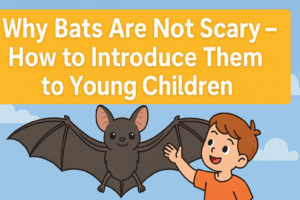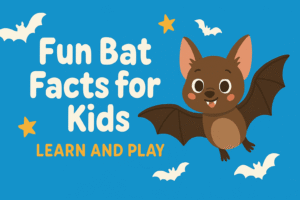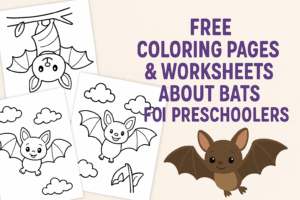For some reason, bats get a bad rap—like they’re all creepy cave dwellers with a thirst for blood. But here’s the thing: bats are actually awesome. They’re pollinators, pest-eaters, nighttime ninjas—and believe it or not, they’re super fascinating once you dig in.
So how do you teach your kids about bats without boring them to pieces or making them think they’re just mini vampires?
Glad you asked. Let’s break this down into bite-sized, super-fun (and slightly silly) ways to help kids fall in love with these misunderstood winged wonders.
Step 1: Flip the Script – Bats Are Cool, Not Creepy
Start by reframing the conversation.
Most kids associate bats with Halloween, Dracula, and “AHHH!! It’s in my hair!” type myths. Let’s shift that.
Try something like:
“Hey, did you know bats pollinate bananas and eat thousands of mosquitoes every night?”
OR:
“Want to meet the real Batman of the animal kingdom?”
When you turn them into the heroes of the story, your kids will be way more likely to lean in and listen.
Step 2: Learn Through Play
Kids don’t want a lecture. They want to PLAY. So here are a few bat-themed activities that sneak in education while keeping the giggles going.
🦇 Bat Tag
- One kid is the bat, blindfolded (or eyes closed).
- Others are “moths.”
- The bat uses “echolocation” by clapping. Moths respond with one clap.
- The bat has to locate a moth by sound alone.
Learning Objective: Teaches kids how bats use echolocation to navigate in the dark.
Bat Fact Bingo
Make a simple bingo sheet with bat facts like:
- “Can fly”
- “Pollinates flowers”
- “Sleeps upside-down”
- “Eats fruit”
Call out the facts and let your kids mark them off.
Winner gets a bat cookie or gets to wear a homemade bat cape.
Step 3: Read Awesome Bat Books
Let me tell you, nothing works like a charming picture book when it comes to melting bat fear.
Here are a few favorites:
- “Stellaluna” by Janell Cannon
A sweet story about a fruit bat who learns that being different is okay. - “Bats at the Beach” by Brian Lies
A fun, rhyming tale of bats going on a nighttime beach trip. Think: Bats + S’mores. - “Nightsong” by Ari Berk
Gorgeous illustrations and poetic storytelling about a young bat learning to use echolocation.
Pro tip: Use dramatic voices. Your bat voice should be slightly squeaky and totally adorable.
Step 4: Get Science-y Without the Boredom
Bats are packed with fascinating facts. You just need the right delivery.
Fun Bat Facts to Drop Casually:
- Some bats can eat 1,000 mosquitoes an hour. (Yes, we should all say thank you.)
- Bats are the only mammals that truly fly (not glide like flying squirrels).
- Bat poop is called guano—and it’s actually really good fertilizer. (Cue the giggles.)
- Vampire bats DO exist, but they mostly feed on cow blood, not humans. Also, they don’t suck—they lap it up like kittens.
You can even grab a free bat fact coloring sheet online and make it into a trivia contest while they color.
Step 5: Make Bat Crafts!
Arts and crafts = hands-on learning + quiet time (you’re welcome, parents).
Here are a few easy ones:
Handprint Bats
- Trace your kid’s hands (for wings)
- Add a round body in the middle
- Decorate with googly eyes, fangs, and glitter if you’re fancy
Bat Masks
- Cut out paper masks and let them color and design their own bat superhero.
- Don’t forget the string so they can fly around the living room.
Toilet Roll Bats
- Use an empty toilet paper roll as the body.
- Add construction paper wings, little fangs, and eyes.
Boom—recycling and crafting all in one.
Step 6: Watch Bat Videos (a.k.a. Screen Time With a Side of Learning)
Let’s be honest. If there’s a way to turn bat learning into Netflix-worthy entertainment, do it.
Here are a few video resources worth checking out:
- PBS Kids – Wild Kratts “Flying Creatures” episodes
- National Geographic Kids – “Bats 101”
- SciShow Kids – “Why Do Bats Hang Upside Down?”
Even YouTube has amazing bat cave tours in 360°, and kids LOVE seeing real baby bats wrapped like tiny burritos.
Step 7: Go on a Bat Walk (Real or Imaginary)
If you live near a park, nature reserve, or even a spot with trees and water, you can sometimes spot bats at dusk.
Bring a flashlight, some binoculars, and your best bat-sighting attitude. Stay quiet, look up, and see if you can catch their fluttery silhouettes against the evening sky.
No bats nearby? No problem. Go on an imagination walk around your backyard and pretend you’re flying.
Ask questions like:
- “If you were a bat, where would you hide during the day?”
- “What bugs would you want to eat tonight?”
- “Would you want wings or super hearing?”
Bonus: Create a “Bat Learning Day”
Make it a whole themed day! Here’s a sample schedule:
| Time | Activity |
|---|---|
| 9:00 AM | Bat Story Time (read Stellaluna) |
| 10:00 AM | Echolocation Tag |
| 11:00 AM | Bat Crafts (handprint bats) |
| 12:00 PM | Bat-themed lunch (banana slices, “bat wings” chicken tenders) |
| 1:00 PM | Watch a bat documentary or video |
| 2:00 PM | Bat Fact Bingo |
| 3:00 PM | Creative writing: “If I Were a Bat…” |
Kids love structure when it’s wrapped in fun.
Final Thoughts: Bats Deserve Better
Teaching your kids about bats isn’t just about adding more animal facts to their brains.
It’s about:
- Busting myths
- Building empathy
- Inspiring curiosity
And most importantly—it’s about having fun together.
Your kids won’t remember every single bat fact…
…but they will remember that day they wore bat masks, chased moths, and laughed their heads off learning that bat poop is actually valuable.
And who knows? You might just end up loving bats too.




